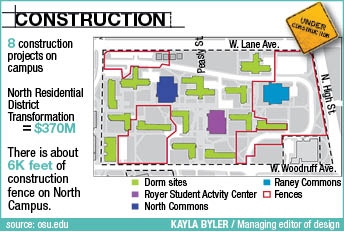Interim President Joseph Alutto said he considers the construction on Ohio State’s campus to be “one of the wonderful tensions in life.”
“You can’t improve facilities that are available to you as students unless you have construction, so that means some students, some faculty and some staff are going to have to live through the construction period, and the beneficiaries then are not going to be the people who live through the construction period but the ones who come after, and that’s just life,” Alutto said in a Feb. 11 interview with The Lantern.
The inevitable process Alutto spoke of, however, has left some students dissatisfied.
Sarah Kasper, a second-year in speech and hearing science and resident of Haverfield House, said living on North Campus during “the construction period” has been frustrating and has made her partially regret her decision to live on campus for a second year.
Kasper’s solution: offer a stipend for students who have to deal with the construction.
“I don’t think it’s fair for North and South Campus students to be paying for the same amount of money while North Campus students are living in a construction zone,” she said.
There are currently eight construction projects taking place on OSU’s campus, one being the $370 million North Residential District Transformation, which aims to construct 11 new buildings on North Campus, according to the campus construction map on OSU’s website.
North Campus isn’t the only area to see recent construction, as the $171 million South Campus High Rise Renovation and Addition Project, which renovated several South Campus residence halls, was completed at the beginning of Fall Semester.
“We spend a lot of time now, as we have with the North Residential facility, trying to figure out, how do we phase the construction in such a way that we minimize construction to students?” Alutto said. “Sometimes there’s more disruption than you’d like at a particular quadrant of campus, but it’s something we spend a lot of time trying to anticipate.”
Briana Albert, a second-year in early and middle childhood studies and resident of Nosker House, said OSU “isn’t doing a terrible job” of phasing the construction, but improvements could be made.
“They should try to do what they need to do when the majority of students aren’t around, such as breaks and weekends,” Albert said.
Albert also mentioned the inconvenience of construction fences.
“My friends and I once got stuck inside the fences on a rainy night at 2 a.m. We were returning to our dorm and there was an opening from the fence on High Street, which wasn’t supposed to be there since we got trapped between the fences. We had to climb them in order to get out because it was so confusing,” she said.
Kasper agreed the fences have been an inconvenience.
“The fencing does prohibit me from getting from point A to point B,” she said.
Administration and Planning spokeswoman Lindsay Komlanc said there is about 6,050 feet of construction fence on North Campus, a figure that accounts for the more permanent fencing in the area that will be up through the next academic year.
“It does not include any fencing that might go up for a short time frame to facilitate work outside of the main fencing,” she said.
Komlanc said students should be aware of the purpose of the fences.
“When thinking about construction fencing, please understand that the fencing is in place for the safety of the campus community to help clearly mark our construction zone and clearly (mark) safe paths of travel,” Komlanc said.
Although the fences are put in place for safety, Kasper said she is frustrated with having to see fences and bulldozers right outside her front door.
Alutto said, though, construction is a good thing.
“If there was no construction going on on this campus, you ought to worry, ‘What does it mean?’ It’s like everything else, you have to keep it in balance … We have segments of campus that are disrupted, but it’s all progress,” he said.
Alutto also said he is not concerned about the effects of construction on potential students.
“If you were here when we were rebuilding the library, when we were building the Ohio Union, when the RPAC was going up, you think of the years over which that’s happened, we recruited some (current OSU students) during that period, and (they) came here because of the nature of this university and the commitment we have to continue to grow, so I’m not worried about it,” he said.



